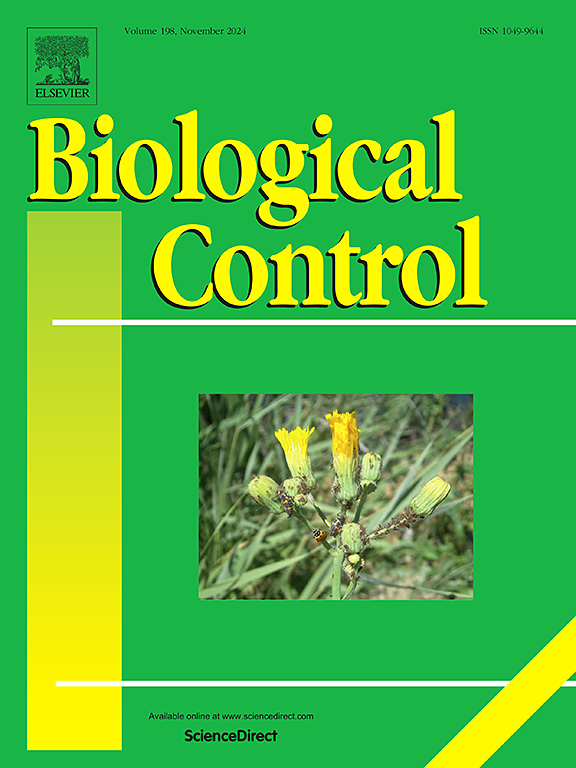Differences in abundance of Thaumatotibia leucotreta and its natural enemies between organic and conventionally farmed citrus ecosystems
IF 3.7
2区 农林科学
Q2 BIOTECHNOLOGY & APPLIED MICROBIOLOGY
引用次数: 0
Abstract
False codling moth (FCM), Thaumatotibia leucotreta (Meyrick) (Lepidoptera: Tortricidae) is endemic to southern Africa and is an important pest in a number of fruit industries, most notably, in the South African citrus industry, as it is considered a phytosanitary pest by many export destinations. Citrus packhouses in South Africa have reported lower infestation of T. leucotreta in fruit from organically farmed orchards than conventionally farmed orchards. Therefore, field surveys were conducted to determine if T. leucotreta infestation was lower on organic citrus farms and to compare natural enemy abundance and species richness between the two farming types. In pheromone trap field surveys, wild adult T. leucotreta numbers were significantly higher in conventionally farmed Palmer Navel and Newhall Navel orange orchards than in matching orchards on neighbouring organic farms. Pitfall trapping recorded significantly higher arthropod generalist predator abundance and species richness in organic farms. Organic orchards had a mean of 7.3 (± 0.6, standard error (SE)) distinct predatory species per trap whereas in conventional orchards 3.9 (± 0.4) species were recorded per trap. Ants, rove beetles, pseudoscorpions and crickets were significantly more abundant in organic orchards. No significant difference was found in spider abundance between organic and conventional citrus orchards. Soil from conventional orchards did not reveal a significantly different incidence of entomopathogenic nematode (EPN) and entomopathogenic fungus (EPF) isolates than the soil from organic orchards. There was, however, a difference between the dominant species in EPF and EPNs in organic and conventional orchard soils. The EPF, Metarhizium anisopliae, was the dominant species in organic soils (81 % of isolates), while Beauveria bassiana was dominant in conventional soils (66 % of isolates). Of the few EPN isolates obtained, the majority in conventional soils (87 %) were Heterorhabditis zealandica, while in organic soils the majority (75 %) were identified to be H. bacteriophora. The findings of this study provide evidence for reduced T. leucotreta infestation in organic citrus orchards, suggesting increased generalist predator abundance as a possible contributing factor.
有机和常规种植柑橘生态系统中 Thaumatibia leucotreta 及其天敌数量的差异
假冷蛾(taumatotibia leucotreta (Meyrick))是非洲南部特有的害虫,是许多水果行业的重要害虫,特别是在南非柑橘行业,因为它被许多出口目的地视为植物检疫害虫。南非的柑橘包装厂报告说,有机种植果园的水果中白尾曲霉的感染率低于传统种植果园。因此,通过实地调查,确定有机柑橘农场的白僵螺旋体侵染是否更低,并比较两种耕作方式之间的天敌丰度和物种丰富度。在信息素诱捕器现场调查中,帕尔默脐橙园和纽霍尔脐橙园的野生成虫数量显著高于邻近有机农场的相应果园。陷阱诱捕法显著提高了有机农场节肢动物通用性捕食者的丰度和物种丰富度。有机果园平均每个陷阱捕获7.3(±0.6,标准误差(SE))种不同的捕食性昆虫,而常规果园平均每个陷阱捕获3.9(±0.4)种不同的捕食性昆虫。有机果园中蚂蚁、甲虫、假蝎子和蟋蟀的数量显著高于有机果园。有机果园与常规果园的蜘蛛数量无显著差异。常规果园土壤昆虫病原线虫(EPN)和昆虫病原真菌(EPF)分离株的发病率与有机果园土壤没有显著差异。然而,有机果园土壤和常规果园土壤中EPF和epn的优势种存在差异。绿僵菌(绿僵菌)是有机土壤的优势菌种(81%),而白僵菌(白僵菌)是常规土壤的优势菌种(66%)。在获得的少数EPN分离株中,常规土壤中的大多数(87%)为西兰异芽孢杆菌(Heterorhabditis zealandica),而有机土壤中的大多数(75%)被鉴定为嗜菌杆菌(h.p urhora)。本研究结果为有机柑橘果园中白僵菌的侵染减少提供了证据,表明多能捕食者丰度的增加可能是一个促进因素。
本文章由计算机程序翻译,如有差异,请以英文原文为准。
求助全文
约1分钟内获得全文
求助全文
来源期刊

Biological Control
生物-昆虫学
CiteScore
7.40
自引率
7.10%
发文量
220
审稿时长
63 days
期刊介绍:
Biological control is an environmentally sound and effective means of reducing or mitigating pests and pest effects through the use of natural enemies. The aim of Biological Control is to promote this science and technology through publication of original research articles and reviews of research and theory. The journal devotes a section to reports on biotechnologies dealing with the elucidation and use of genes or gene products for the enhancement of biological control agents.
The journal encompasses biological control of viral, microbial, nematode, insect, mite, weed, and vertebrate pests in agriculture, aquatic, forest, natural resource, stored product, and urban environments. Biological control of arthropod pests of human and domestic animals is also included. Ecological, molecular, and biotechnological approaches to the understanding of biological control are welcome.
 求助内容:
求助内容: 应助结果提醒方式:
应助结果提醒方式:


